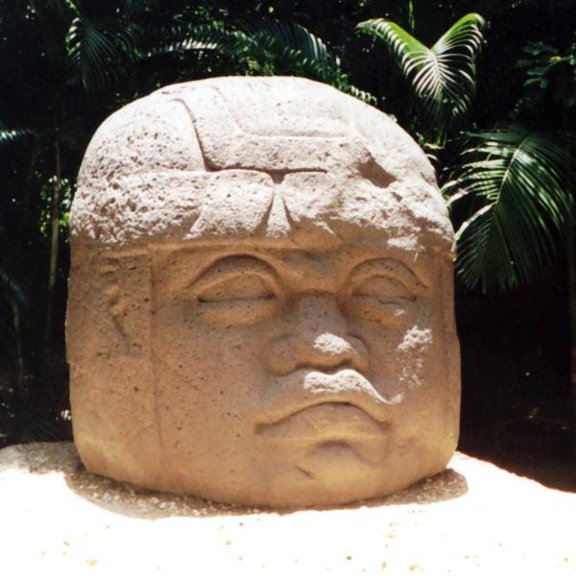
The Olmec were an early Mesoamerican people who left behind dramatic sculptures. Some of these are enormous heads. The one above, known as Monument 1, is nine feet tall. Picture credit: Hajor. Used under a Creative Commons Attribution-Share Alike 3.0 Unported license and a 2.0 Generic license, on Wikimedia Commons.
"Rubber people", Olmec--that's what the Aztecs called their precursors in Mesoamerica. The Olmec lived along the Gulf of Mexico, about 3,000 years ago. They came by their name because they harvested rubber and turned it into useful objects. The most well known of these objects was a rubber ball.
This was no ordinary ball. The Olmec played a highly ritualized game in which the stakes could be life or death. The ball court on which they played was about the size of a modern football field and was lined with stone. Archeologists believe the Olmec had a powerful influence on civilizations that followed. These civilizations included the Maya and the Aztecs. Both Maya and Aztecs used rubber extensively.
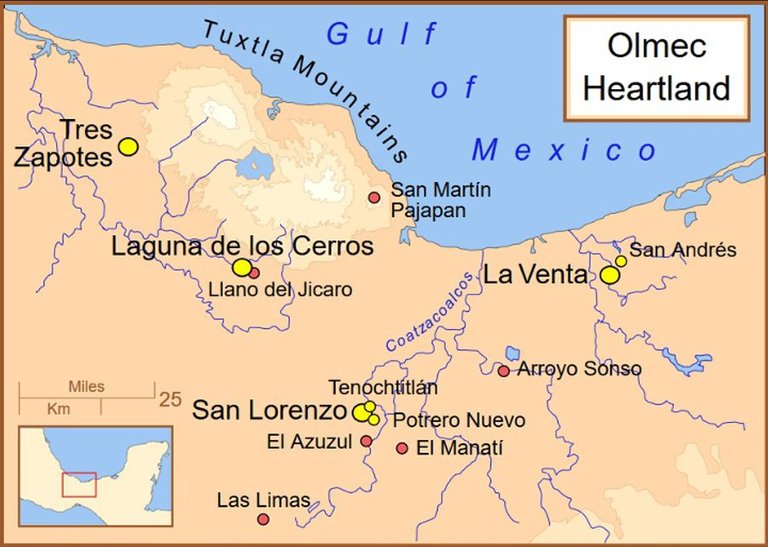
This map shows the approximate location of the Olmec civilization. The map is color-keyed: Yellow shows the location of communities, red the location of unearthed artifacts not connected to communities. Picture credit: Madman2001. Used under a Creative Commons Attribution-Share Alike 3.0 Unported license, and a Creative Commons-Share Alike 2.5, 2.0 or 1.5 Generic license, on Wikimedia Commons.
When Hernan Cortes, the Spanish Conquistador, encountered the Aztecs, he noted their highly ritualized ball games. He guessed these games had religious significance. It is reported that Cortes attended one game with the Aztec Emperor, Montezuma. Archeologists have uncovered a large stadium in which the games were played. In the ruins, they found human remains. It seems combatants, probably the losers, were decapitated at the end of a contest.
%202.0%20cropped.jpg)
This painting of a ballplayer is cropped from a larger mural discovered in an archeological excavation at Tepantitla. Ball games were a custom throughout early Mesoamerican cultures. Researchers believe the earliest games took place 3,700 years ago.
Because the Spanish Conquistadors believed they were on a mission to spread Christianity, they banned all expressions of pagan religion. This banning included ball games. Besides banning activities, the Conquistadors burned records left by early civilizations. Despite this effort to erase culture, contemporary researchers have discovered evidence that helps them understand early Mesoamerica. One thing that has become evident is that rubber had many uses among these people. There were rubber sandals, rubber statues, and rubber balls. Rubber was used as an adhesive and also for waterproofing.
Latex "bleeding" from a tree native to Mesoamerica. Castilla Elastica, (Panama Rubber Tree), was the source of latex for pre-Columbian cultures. A vine that grows around the tree, Ipomoea, (morning glory), is the source of juice that was used to render latex a more consumer-ready material. Picture credit: Museo Leone de Ujarras. Used under a Creative Commons Attribution-Share Alike 3.0 Unported license on Wikimedia Commons.
Latex
Natural rubber is made from latex, and latex comes from plants. Different areas of the world have given rise to a variety of latex-producing plants. In Mesoamerica, the plant is the Castilla Elastica. In Africa, it is most likely to be a vine, Landolphia owariensis. In Asia and South America, it is likely to be a tree, the Hevea Brasiliensis. In each area, these plants are the chief source of latex.
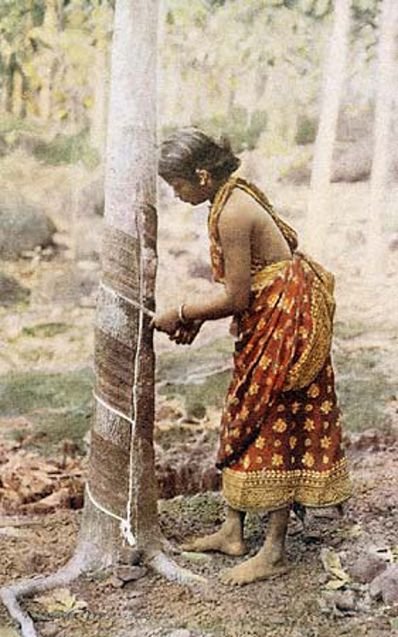
The picture shows a woman in Ceylon 'tapping' a rubber tree. In 1876 Henry Wikham smuggled seeds from Hevea Brasiliensis (Amazon rubber tree) and delivered them to the Royal Botanical Gardens in London. The seeds were cultivated and Hevea Brasiliensis was introduced into Southeast Asia. Rubber plantations flourished there and today this area of the world is the greatest source of latex. Picture credit: the author is unknown, the picture was taken in 1920 and so is in the public domain. Wikimedia Commons.
Early Mesoamericans developed a technique for treating latex so it could be adapted to different functions. They mixed raw latex with juice from the morning glory in varying proportions, depending on what they needed the rubber for. Although the Spanish did take rubber back to Europe, Europeans did not find much use for it until many years had passed.
The road to modern industrial use of latex advanced unevenly, with missteps and breakthroughs. In 1736 a French explorer, Charles-Marie de La Condamine, returned from a nine-year journey to South America. The last part of his travels took him on a raft voyage through the Amazon. It was here he saw "weeping" trees. These were the latex-bearing Hevea Brasiliensis. Little practical use was made of Condamine's information, until Joseph Priestly, a British scientist, noted its application as an eraser. Priestly described its ability, when rubbed against paper, to remove dark pencil marks--hence the name "rubber".
Another advance in the development of rubber as a commodity came with the introduction of the waterproof raincoat. Charles Macintosh, in collaboration with Thomas Hancock, devised a method of combining latex with a turpentine/naphtha solution. This compound was pressed between two layers of cloth. Thus, in 1824, Hancock and Macintosh presented the Mackintosh raincoat to the world.
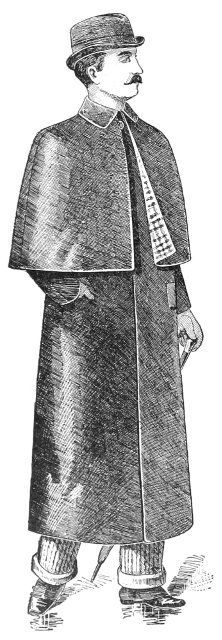
This picture of a Mackintosh coat comes from an 1893 catalogue, "Carson, Pirie, Scott & Co". The picture is in the public domain. Wikimedia Commons.
Although commercial application of natural latex was becoming more sophisticated, not until rubber was vulcanized could widespread industrial use be realized. Before vulcanization, rubber was sticky. It melted at high temperatures and cracked at low temperatures. Charles Goodyear (1800-1860) struggled to come up with a formula that would correct these defects. Finally, in 1839, he stumbled on a process that worked. He combined rubber, sulfur and lead oxide. This still did not produce a satisfactory product. Then, he accidentally dropped a glob of his compound onto a hot stove. When the material cooled, he realized he'd found a way to make rubber more marketable. His accident had created a resilient and tough substance. Goodyear's "vulcanized" rubber would have wide industrial application.
A bit of trivia: Goodyear, the company, was not created by Charles Goodyear but by an entrepreneur, Frank Sieberling. In 1898 Sieberling established the Goodyear Tire and Rubber Company with money he'd borrowed from a relative. Today, the Goodyear Tire and Rubber Company is a multinational corporation with annual sales exceeding fifteen billion dollars. When Charles Goodyear died, he was two hundred thousand dollars in debt.
Rubber Barons
In the later half of the nineteenth century, regulation and oversight of industry was virtually nonexistent. This was an age of exponential capital growth, and unbridled exploitation of natural resources. These resources included rubber.
With vulcanization, the potential for rubber profits grew, but no single event had as dramatic an effect on rubber's commercial development as the invention of the pneumatic tire. With this innovation, in the late 1800s, tire production exploded. The appetite for tires was fueled by a popular interest in bicycles and automobiles.
John Boyd Dunlop is credited by many with inventing the pneumatic tire in 1887, but the patent for this tire was granted to another man, Robert William Thompson. Thompson had designed a less commercially viable pneumatic tire in 1847.
%20unknown%20pubic.jpg)
John Boyd Dunlop on a bycicle. Dunlop was a veterinarian. His interest in pneumatic tires arose because his son's bicycle did not offer a smooth ride. Dunlop wanted to make his son's exercise more enjoyable, so he devised a rubber tire that inflated. This simple invention did the trick. The picture is in the public domain. It was published in 1915 and its author is unknown. Wikimedia Commons.
The Hunt for Latex
In order to meet the demand for rubber, vast amounts of latex had to be harvested. The hunt for latex led to a period of egregious human rights violations. Given the lack of oversight, and the enormous potential for profit, latex extraction was pursued without moral restraint, and without regard for the consequences to human life.
Indigenous people on several continents were pressed into involuntary service. In many cases they were tortured and enslaved. Contemporaneous descriptions of the circumstances under which people were forced to work offer indisputable proof of extreme cruelty. Three specific examples of this cruelty, on three continents, are presented here:
An Example of Abuse in South America
Putumayo
The Putumayo River wends its way through the Peruvian rainforest. In the late 1800s, latex hunters found the Putumayo River basin to be richly endowed with Hevea Brasiliensis--the latex-producing tree. The Peruvian Amazon Company, PAC, set up operations. A workforce was needed. The company found its laborers in the indigenous people of the rainforest. These people were recruited, against their will.
In 1909, a small British publication, The Truth, published an account of what life was like for indigenous rubber workers. A witness, Walter Hardenburg, had been imprisoned by PAC for two years. He saw horrors during his imprisonment, horrors he could not ignore. Upon his release, he described beatings, enslavement, rape and murder. The article in The Truth was entitled "The Devil's Paradise: A British-owned Congo". Because PAC was British owned, a commission was established to investigate Hardenburg's claims. The commission found circumstances to be even worse than Hardenburg had reported.
Despite public outcry, PAC continued its operations, partly because WWI loomed and rubber was needed for the war effort.
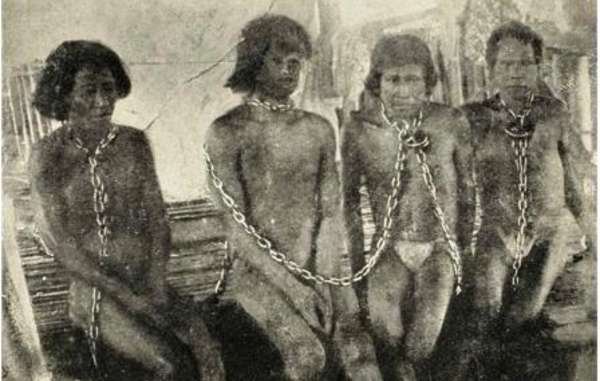
This picture of chained Putumayo workers appears in Walter Harenburg's book: "The Putumayo, the Devil's Paradise; Travels in the Peruvian Amazon Region and an Account of the Atrocities Committed upon the Indians Therein". The book was published in 1912 and is in the public domain because its copyright has expired in the United States. Wikimedia Commons.
An Example of Abuse in Africa
The Congo
The headline in The Truth referred to a scandal that had embarrassed Leopold II, King of Belgium. In 1885, at a meeting of European leaders, Leopold had been given a free hand to control the Congo. This gift to Leopold was part of the notorious 'Scramble for Africa': The continent was carved up into spheres of influence so that each European nation could freely exploit a defined area. Leopold declared himself King of the Congo Free State. His mission, he asserted, was to end the slave trade in the Congo and to bring civilization to the indigenous people. What he actually did was enslave the people in order to reap large profits for himself.
The first product he sought to exploit was ivory. In time, with the rise in rubber prices, he changed his focus to rubber. In a scandal much like the one in Putumayo, it was revealed by a British Commission report that horrific conditions existed in the Congo. People--men, women, children--were kidnapped and forced to work. They were given quotas to fulfill each day. Failure to reach the quota resulted in maiming--loss of a hand or foot. In 1908, in the face of widespread outrage, Leopold was obliged to give up control of the Congo, but he didn't do so at a loss. He made the Belgium government pay him for turning over control of the territory.
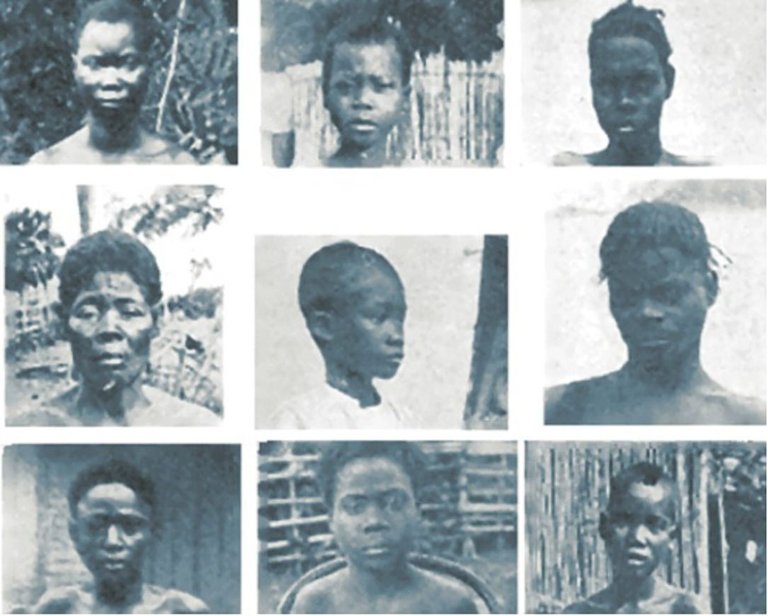
These are the faces of people who were maimed on rubber plantations owned by Leopold II of Belgium. I cropped this picture, because the original is very disturbing. In that picture, the amputated extremities are clearly shown. If you wish to see that, you may here. I didn't want to impose the image on anyone. Missionaries in the Congo were outraged by what they saw, and some of the pictures from that time were the work of missionaries.
An Example of Abuse in Asia
French Colonial Indochina
An area in Southeast Asia that was for a time under French colonial rule was known as Indochina. Countries that today would be included, geographically, in that territory are Vietnam, Laos and Cambodia. With the rubber boom, lands were cleared to make way for large rubber plantations. This land appropriation disrupted the traditional culture and displaced small landowners. As had been true in the Congo and Putumayo, indigenous people were conscripted to work on the plantations. Michelin, the tire company, owned several large rubber plantations in French colonial Indochina. Conditions were so harsh on the Michelin plantations, that is estimated one location alone saw 17,000 workers die over a period of twenty years.
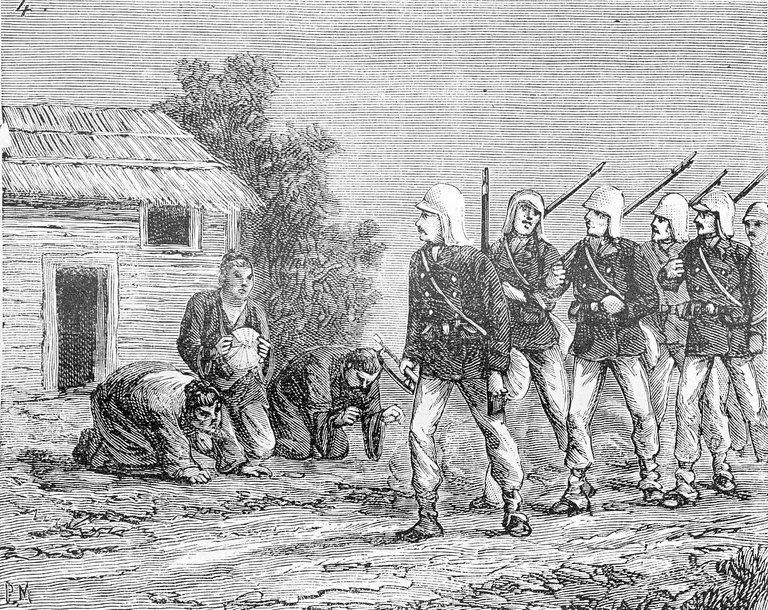
Villagers in Vietnam kowtowing to French soldiers. According to the picture's citation, villagers were expected to show respect to the French. This picture is in the public domain. Wikimedia Commons. The picture was derived from a book, "Guerre du Tonkin", by Lucian Huard. A digital version of the book is available at the Haithe Trust.
Rubber Today, and in the Future
Not touched on in this essay so far is the environmental impact of rubber development. This is a multilayered issue and rich material for a future blog. A few of the most important environmental issues are:
*Displacement of natural rainforests with rubber plantations
*Water pollution
*Air pollution
*Soil pollution
A pile of shredded tires (Tire Derived Aggregate)
Shredded tires are used as fill in construction. Picture credit: Shuki. Used under a Creative Commons Attribution-Share Alike 3.0 Unported license on Wikimedia Commons.
One of the challenges facing the rubber industry today is inherent in the process of vulcanization. Tires are designed to last. And they do, well beyond their useful lifetimes. Creative solutions to tire disposal include using them in buildings, shredding them and repurposing them as construction material. Processes for reversing vulcanization--that is breaking the chemical bonds that make rubber so durable--are being developed.
Natural rubber (latex before it is vulcanized) degrades naturally. Microorganism and the sun break it down so it does not pollute the environment, as commercial rubber does.
Humans took a great step forward in commerce when they made rubber durable. We have learned in recent years that a great step forward in industry may not actually be an advance for the planet, or for life that depends on the planet. It seems that much energy in the future will be devoted to undoing well-intended mistakes of the past.
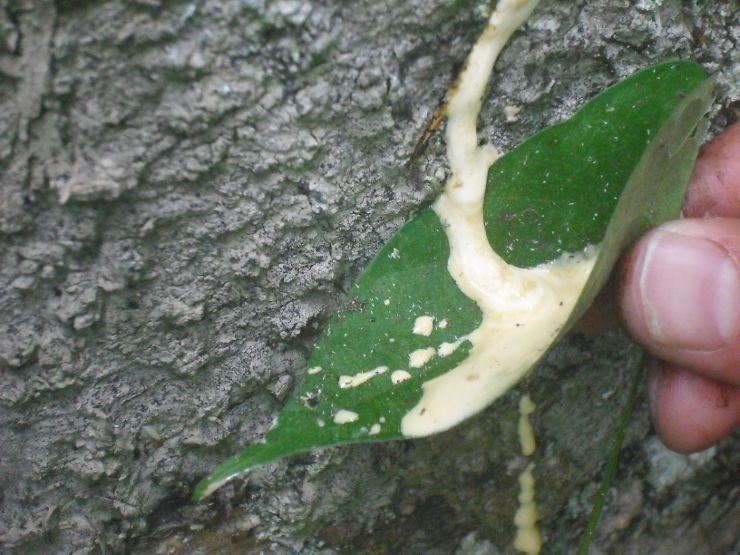
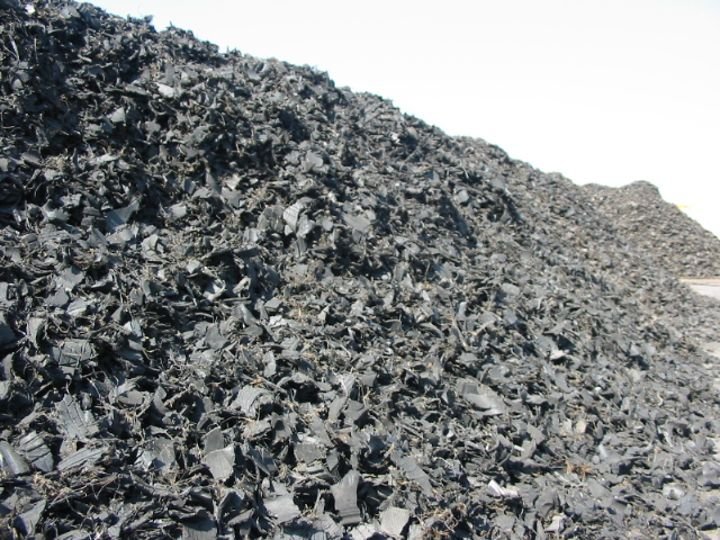
Congratulations @agmoore! You have completed some achievement on Steemit and have been rewarded with new badge(s) :
<p dir="auto"><a href="http://steemitboard.com/@agmoore" target="_blank" rel="noreferrer noopener" title="This link will take you away from hive.blog" class="external_link"><img src="https://images.hive.blog/768x0/https://steemitimages.com/70x80/http://steemitboard.com/notifications/payout.png" srcset="https://images.hive.blog/768x0/https://steemitimages.com/70x80/http://steemitboard.com/notifications/payout.png 1x, https://images.hive.blog/1536x0/https://steemitimages.com/70x80/http://steemitboard.com/notifications/payout.png 2x" /> Award for the total payout received <p dir="auto">Click on any badge to view your own Board of Honor on SteemitBoard.<br /> For more information about SteemitBoard, click <a href="https://steemit.com/@steemitboard" target="_blank" rel="noreferrer noopener" title="This link will take you away from hive.blog" class="external_link">here <p dir="auto">If you no longer want to receive notifications, reply to this comment with the word <code>STOP <blockquote> <p dir="auto">Upvote this notification to help all Steemit users. Learn why <a href="https://steemit.com/steemitboard/@steemitboard/http-i-cubeupload-com-7ciqeo-png" target="_blank" rel="noreferrer noopener" title="This link will take you away from hive.blog" class="external_link">here!You received a 60.0% upvote since you are a member of geopolis and wrote in the category of "geopolis".
To read more about us and what we do, click here.
https://steemit.com/geopolis/@geopolis/geopolis-the-community-for-global-sciences-update-4
Thank you!
This is amazing! Very informative and well constructed. The evils that men do definitely live after them.
Thank you for reading! It was hard work, but I know a lot about rubber now :)